Business Research: Survey Questionnaire on Conspicuous Consumption
VerifiedAdded on 2023/06/11
|6
|1429
|257
Report
AI Summary
This report discusses the use of a survey questionnaire in business research, specifically focusing on conspicuous consumption. The author emphasizes the importance of a well-designed and appealing questionnaire layout to ensure a high response rate. Closed-ended questions were chosen for the survey to facilitate easier understanding and quicker completion by respondents, as well as to simplify data coding and statistical analysis. The research explores how conspicuous consumption is linked to social status and influenced by factors such as peer pressure and personal traits. The survey questions are designed to gather insights into customers' opinions regarding their social status and motivations for shopping, using simple and easily understandable language. Key considerations in designing the questionnaire layout, including relevance, clarity, objectivity, and structure, are also addressed. Desklib provides access to similar resources and solved assignments for students.
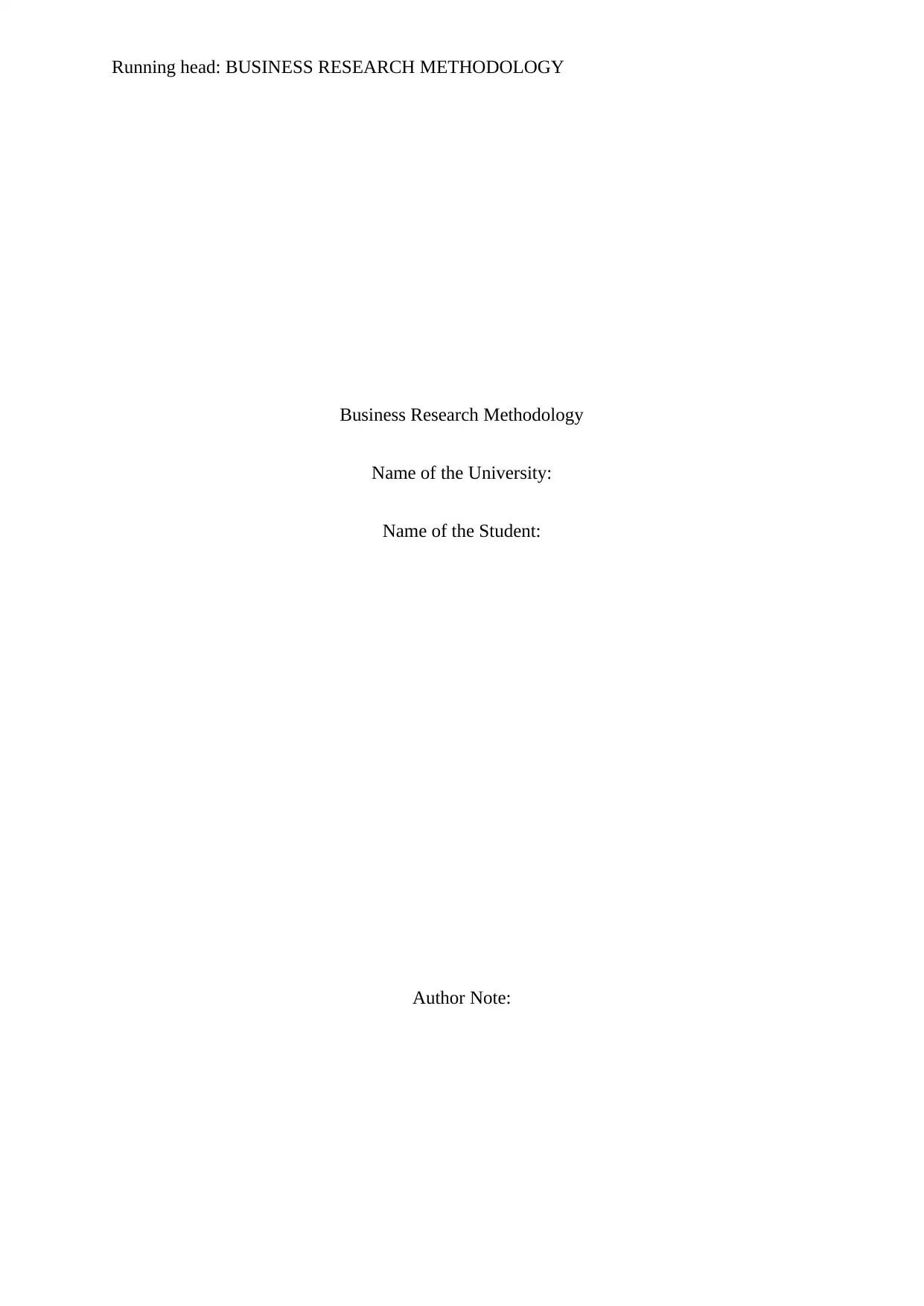
Running head: BUSINESS RESEARCH METHODOLOGY
Business Research Methodology
Name of the University:
Name of the Student:
Author Note:
Business Research Methodology
Name of the University:
Name of the Student:
Author Note:
Paraphrase This Document
Need a fresh take? Get an instant paraphrase of this document with our AI Paraphraser
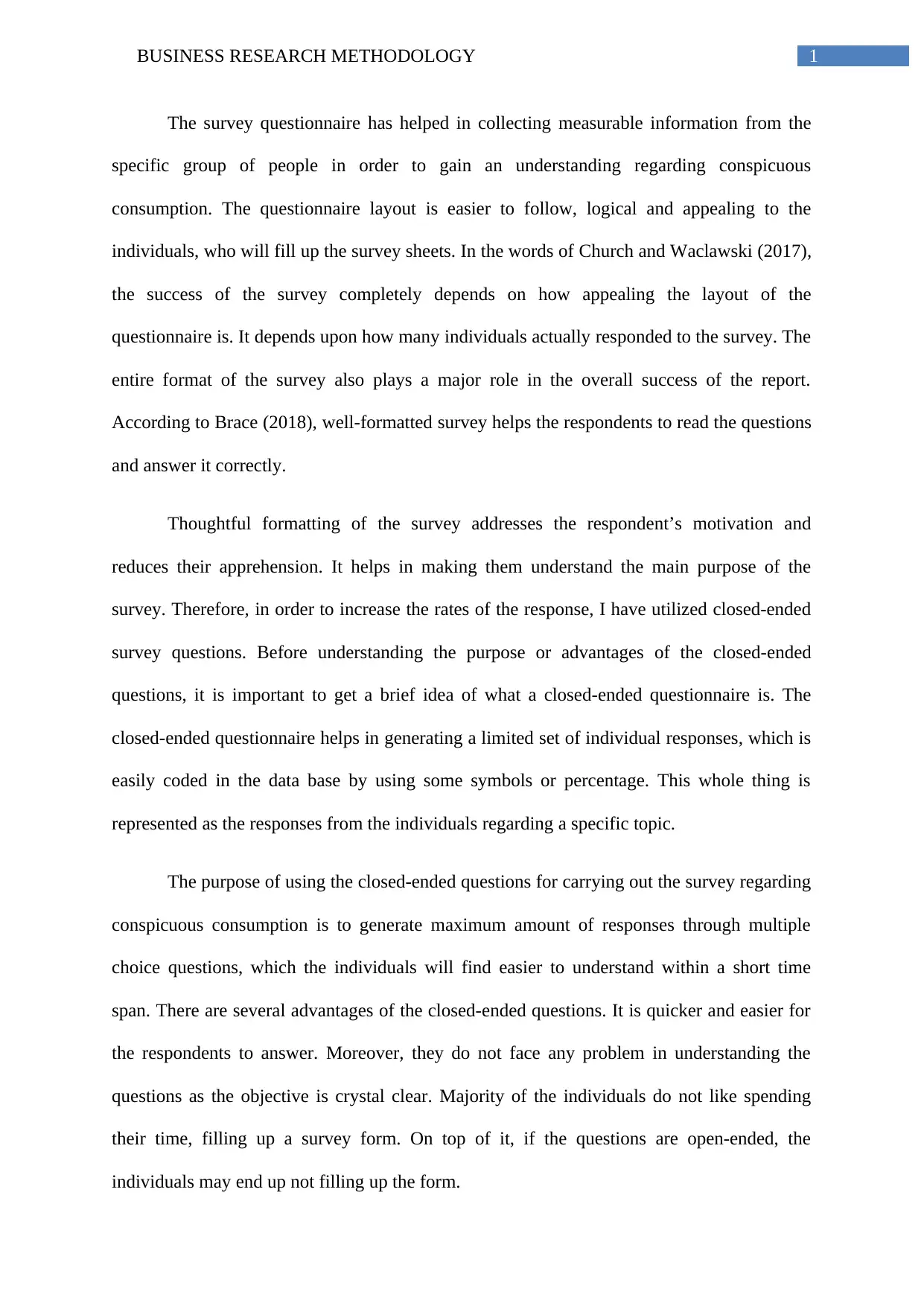
1BUSINESS RESEARCH METHODOLOGY
The survey questionnaire has helped in collecting measurable information from the
specific group of people in order to gain an understanding regarding conspicuous
consumption. The questionnaire layout is easier to follow, logical and appealing to the
individuals, who will fill up the survey sheets. In the words of Church and Waclawski (2017),
the success of the survey completely depends on how appealing the layout of the
questionnaire is. It depends upon how many individuals actually responded to the survey. The
entire format of the survey also plays a major role in the overall success of the report.
According to Brace (2018), well-formatted survey helps the respondents to read the questions
and answer it correctly.
Thoughtful formatting of the survey addresses the respondent’s motivation and
reduces their apprehension. It helps in making them understand the main purpose of the
survey. Therefore, in order to increase the rates of the response, I have utilized closed-ended
survey questions. Before understanding the purpose or advantages of the closed-ended
questions, it is important to get a brief idea of what a closed-ended questionnaire is. The
closed-ended questionnaire helps in generating a limited set of individual responses, which is
easily coded in the data base by using some symbols or percentage. This whole thing is
represented as the responses from the individuals regarding a specific topic.
The purpose of using the closed-ended questions for carrying out the survey regarding
conspicuous consumption is to generate maximum amount of responses through multiple
choice questions, which the individuals will find easier to understand within a short time
span. There are several advantages of the closed-ended questions. It is quicker and easier for
the respondents to answer. Moreover, they do not face any problem in understanding the
questions as the objective is crystal clear. Majority of the individuals do not like spending
their time, filling up a survey form. On top of it, if the questions are open-ended, the
individuals may end up not filling up the form.
The survey questionnaire has helped in collecting measurable information from the
specific group of people in order to gain an understanding regarding conspicuous
consumption. The questionnaire layout is easier to follow, logical and appealing to the
individuals, who will fill up the survey sheets. In the words of Church and Waclawski (2017),
the success of the survey completely depends on how appealing the layout of the
questionnaire is. It depends upon how many individuals actually responded to the survey. The
entire format of the survey also plays a major role in the overall success of the report.
According to Brace (2018), well-formatted survey helps the respondents to read the questions
and answer it correctly.
Thoughtful formatting of the survey addresses the respondent’s motivation and
reduces their apprehension. It helps in making them understand the main purpose of the
survey. Therefore, in order to increase the rates of the response, I have utilized closed-ended
survey questions. Before understanding the purpose or advantages of the closed-ended
questions, it is important to get a brief idea of what a closed-ended questionnaire is. The
closed-ended questionnaire helps in generating a limited set of individual responses, which is
easily coded in the data base by using some symbols or percentage. This whole thing is
represented as the responses from the individuals regarding a specific topic.
The purpose of using the closed-ended questions for carrying out the survey regarding
conspicuous consumption is to generate maximum amount of responses through multiple
choice questions, which the individuals will find easier to understand within a short time
span. There are several advantages of the closed-ended questions. It is quicker and easier for
the respondents to answer. Moreover, they do not face any problem in understanding the
questions as the objective is crystal clear. Majority of the individuals do not like spending
their time, filling up a survey form. On top of it, if the questions are open-ended, the
individuals may end up not filling up the form.
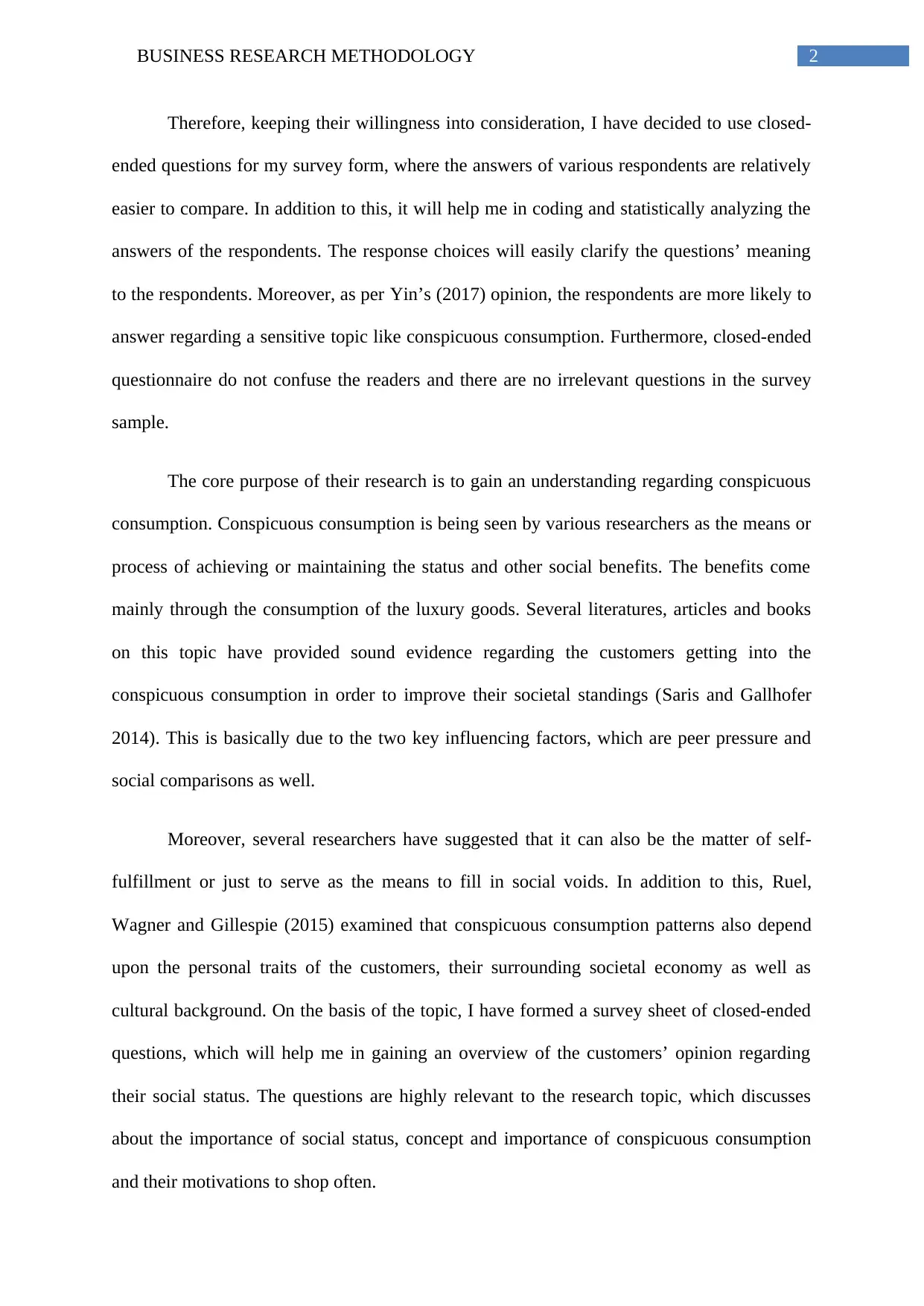
2BUSINESS RESEARCH METHODOLOGY
Therefore, keeping their willingness into consideration, I have decided to use closed-
ended questions for my survey form, where the answers of various respondents are relatively
easier to compare. In addition to this, it will help me in coding and statistically analyzing the
answers of the respondents. The response choices will easily clarify the questions’ meaning
to the respondents. Moreover, as per Yin’s (2017) opinion, the respondents are more likely to
answer regarding a sensitive topic like conspicuous consumption. Furthermore, closed-ended
questionnaire do not confuse the readers and there are no irrelevant questions in the survey
sample.
The core purpose of their research is to gain an understanding regarding conspicuous
consumption. Conspicuous consumption is being seen by various researchers as the means or
process of achieving or maintaining the status and other social benefits. The benefits come
mainly through the consumption of the luxury goods. Several literatures, articles and books
on this topic have provided sound evidence regarding the customers getting into the
conspicuous consumption in order to improve their societal standings (Saris and Gallhofer
2014). This is basically due to the two key influencing factors, which are peer pressure and
social comparisons as well.
Moreover, several researchers have suggested that it can also be the matter of self-
fulfillment or just to serve as the means to fill in social voids. In addition to this, Ruel,
Wagner and Gillespie (2015) examined that conspicuous consumption patterns also depend
upon the personal traits of the customers, their surrounding societal economy as well as
cultural background. On the basis of the topic, I have formed a survey sheet of closed-ended
questions, which will help me in gaining an overview of the customers’ opinion regarding
their social status. The questions are highly relevant to the research topic, which discusses
about the importance of social status, concept and importance of conspicuous consumption
and their motivations to shop often.
Therefore, keeping their willingness into consideration, I have decided to use closed-
ended questions for my survey form, where the answers of various respondents are relatively
easier to compare. In addition to this, it will help me in coding and statistically analyzing the
answers of the respondents. The response choices will easily clarify the questions’ meaning
to the respondents. Moreover, as per Yin’s (2017) opinion, the respondents are more likely to
answer regarding a sensitive topic like conspicuous consumption. Furthermore, closed-ended
questionnaire do not confuse the readers and there are no irrelevant questions in the survey
sample.
The core purpose of their research is to gain an understanding regarding conspicuous
consumption. Conspicuous consumption is being seen by various researchers as the means or
process of achieving or maintaining the status and other social benefits. The benefits come
mainly through the consumption of the luxury goods. Several literatures, articles and books
on this topic have provided sound evidence regarding the customers getting into the
conspicuous consumption in order to improve their societal standings (Saris and Gallhofer
2014). This is basically due to the two key influencing factors, which are peer pressure and
social comparisons as well.
Moreover, several researchers have suggested that it can also be the matter of self-
fulfillment or just to serve as the means to fill in social voids. In addition to this, Ruel,
Wagner and Gillespie (2015) examined that conspicuous consumption patterns also depend
upon the personal traits of the customers, their surrounding societal economy as well as
cultural background. On the basis of the topic, I have formed a survey sheet of closed-ended
questions, which will help me in gaining an overview of the customers’ opinion regarding
their social status. The questions are highly relevant to the research topic, which discusses
about the importance of social status, concept and importance of conspicuous consumption
and their motivations to shop often.
⊘ This is a preview!⊘
Do you want full access?
Subscribe today to unlock all pages.

Trusted by 1+ million students worldwide
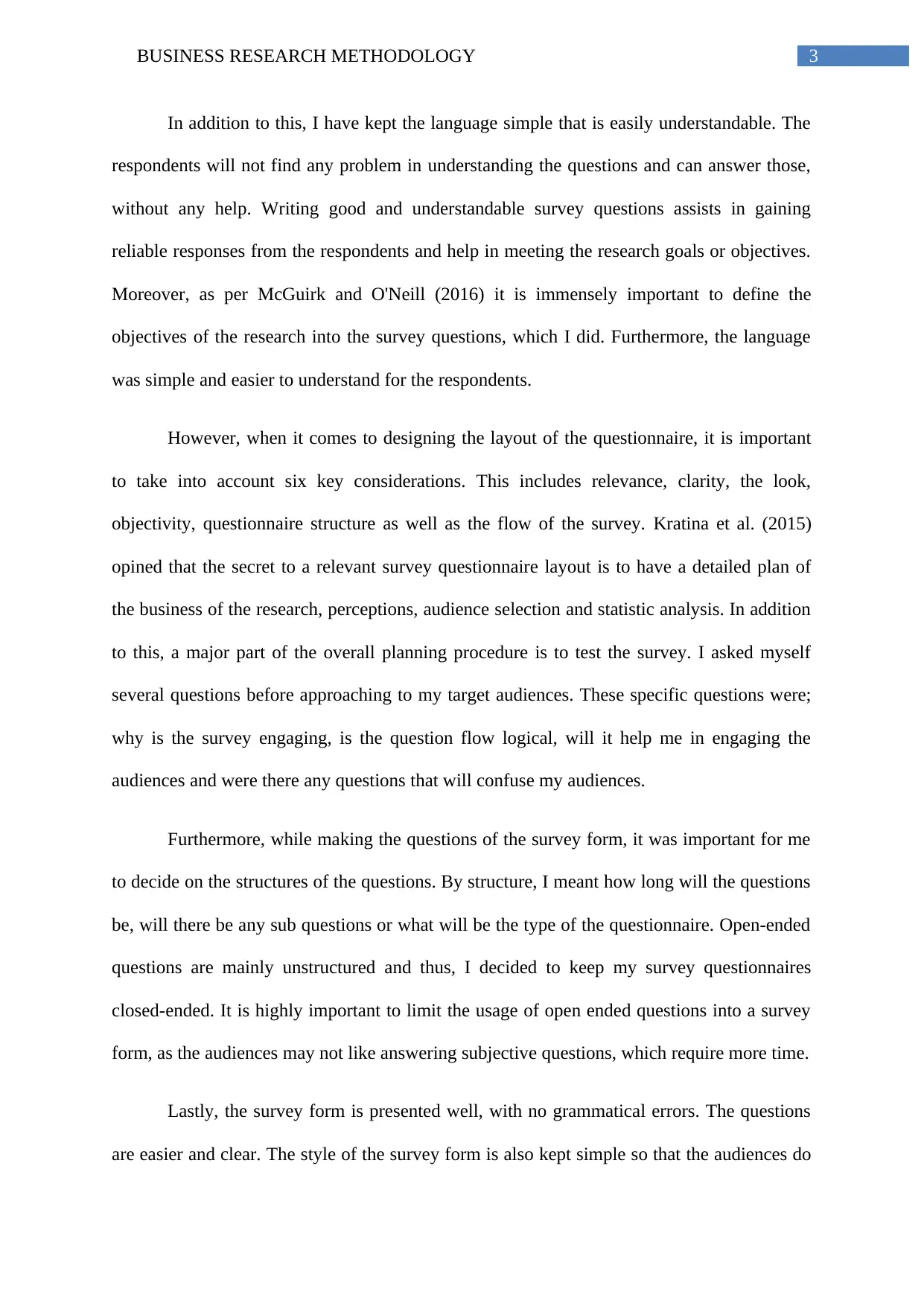
3BUSINESS RESEARCH METHODOLOGY
In addition to this, I have kept the language simple that is easily understandable. The
respondents will not find any problem in understanding the questions and can answer those,
without any help. Writing good and understandable survey questions assists in gaining
reliable responses from the respondents and help in meeting the research goals or objectives.
Moreover, as per McGuirk and O'Neill (2016) it is immensely important to define the
objectives of the research into the survey questions, which I did. Furthermore, the language
was simple and easier to understand for the respondents.
However, when it comes to designing the layout of the questionnaire, it is important
to take into account six key considerations. This includes relevance, clarity, the look,
objectivity, questionnaire structure as well as the flow of the survey. Kratina et al. (2015)
opined that the secret to a relevant survey questionnaire layout is to have a detailed plan of
the business of the research, perceptions, audience selection and statistic analysis. In addition
to this, a major part of the overall planning procedure is to test the survey. I asked myself
several questions before approaching to my target audiences. These specific questions were;
why is the survey engaging, is the question flow logical, will it help me in engaging the
audiences and were there any questions that will confuse my audiences.
Furthermore, while making the questions of the survey form, it was important for me
to decide on the structures of the questions. By structure, I meant how long will the questions
be, will there be any sub questions or what will be the type of the questionnaire. Open-ended
questions are mainly unstructured and thus, I decided to keep my survey questionnaires
closed-ended. It is highly important to limit the usage of open ended questions into a survey
form, as the audiences may not like answering subjective questions, which require more time.
Lastly, the survey form is presented well, with no grammatical errors. The questions
are easier and clear. The style of the survey form is also kept simple so that the audiences do
In addition to this, I have kept the language simple that is easily understandable. The
respondents will not find any problem in understanding the questions and can answer those,
without any help. Writing good and understandable survey questions assists in gaining
reliable responses from the respondents and help in meeting the research goals or objectives.
Moreover, as per McGuirk and O'Neill (2016) it is immensely important to define the
objectives of the research into the survey questions, which I did. Furthermore, the language
was simple and easier to understand for the respondents.
However, when it comes to designing the layout of the questionnaire, it is important
to take into account six key considerations. This includes relevance, clarity, the look,
objectivity, questionnaire structure as well as the flow of the survey. Kratina et al. (2015)
opined that the secret to a relevant survey questionnaire layout is to have a detailed plan of
the business of the research, perceptions, audience selection and statistic analysis. In addition
to this, a major part of the overall planning procedure is to test the survey. I asked myself
several questions before approaching to my target audiences. These specific questions were;
why is the survey engaging, is the question flow logical, will it help me in engaging the
audiences and were there any questions that will confuse my audiences.
Furthermore, while making the questions of the survey form, it was important for me
to decide on the structures of the questions. By structure, I meant how long will the questions
be, will there be any sub questions or what will be the type of the questionnaire. Open-ended
questions are mainly unstructured and thus, I decided to keep my survey questionnaires
closed-ended. It is highly important to limit the usage of open ended questions into a survey
form, as the audiences may not like answering subjective questions, which require more time.
Lastly, the survey form is presented well, with no grammatical errors. The questions
are easier and clear. The style of the survey form is also kept simple so that the audiences do
Paraphrase This Document
Need a fresh take? Get an instant paraphrase of this document with our AI Paraphraser
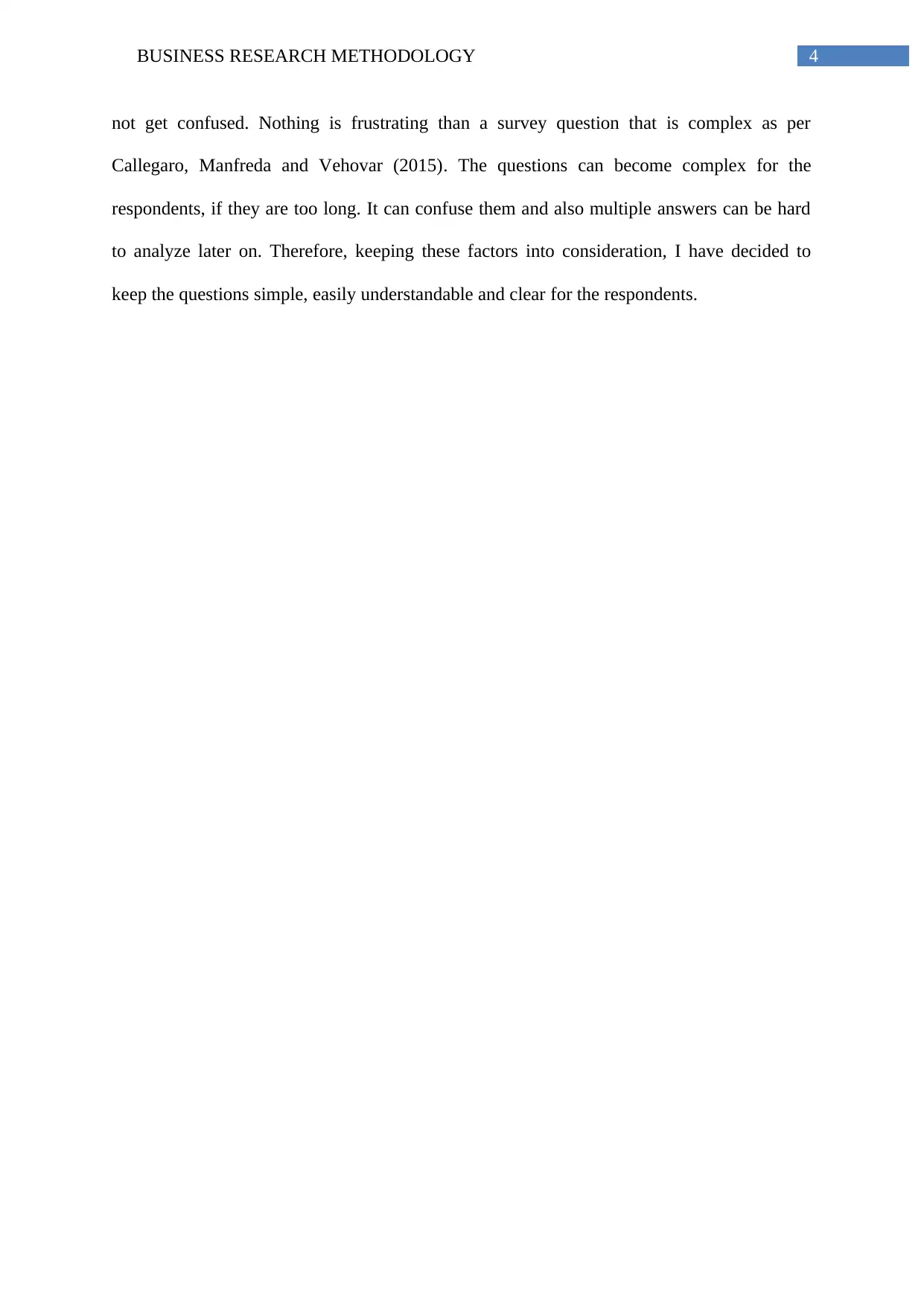
4BUSINESS RESEARCH METHODOLOGY
not get confused. Nothing is frustrating than a survey question that is complex as per
Callegaro, Manfreda and Vehovar (2015). The questions can become complex for the
respondents, if they are too long. It can confuse them and also multiple answers can be hard
to analyze later on. Therefore, keeping these factors into consideration, I have decided to
keep the questions simple, easily understandable and clear for the respondents.
not get confused. Nothing is frustrating than a survey question that is complex as per
Callegaro, Manfreda and Vehovar (2015). The questions can become complex for the
respondents, if they are too long. It can confuse them and also multiple answers can be hard
to analyze later on. Therefore, keeping these factors into consideration, I have decided to
keep the questions simple, easily understandable and clear for the respondents.
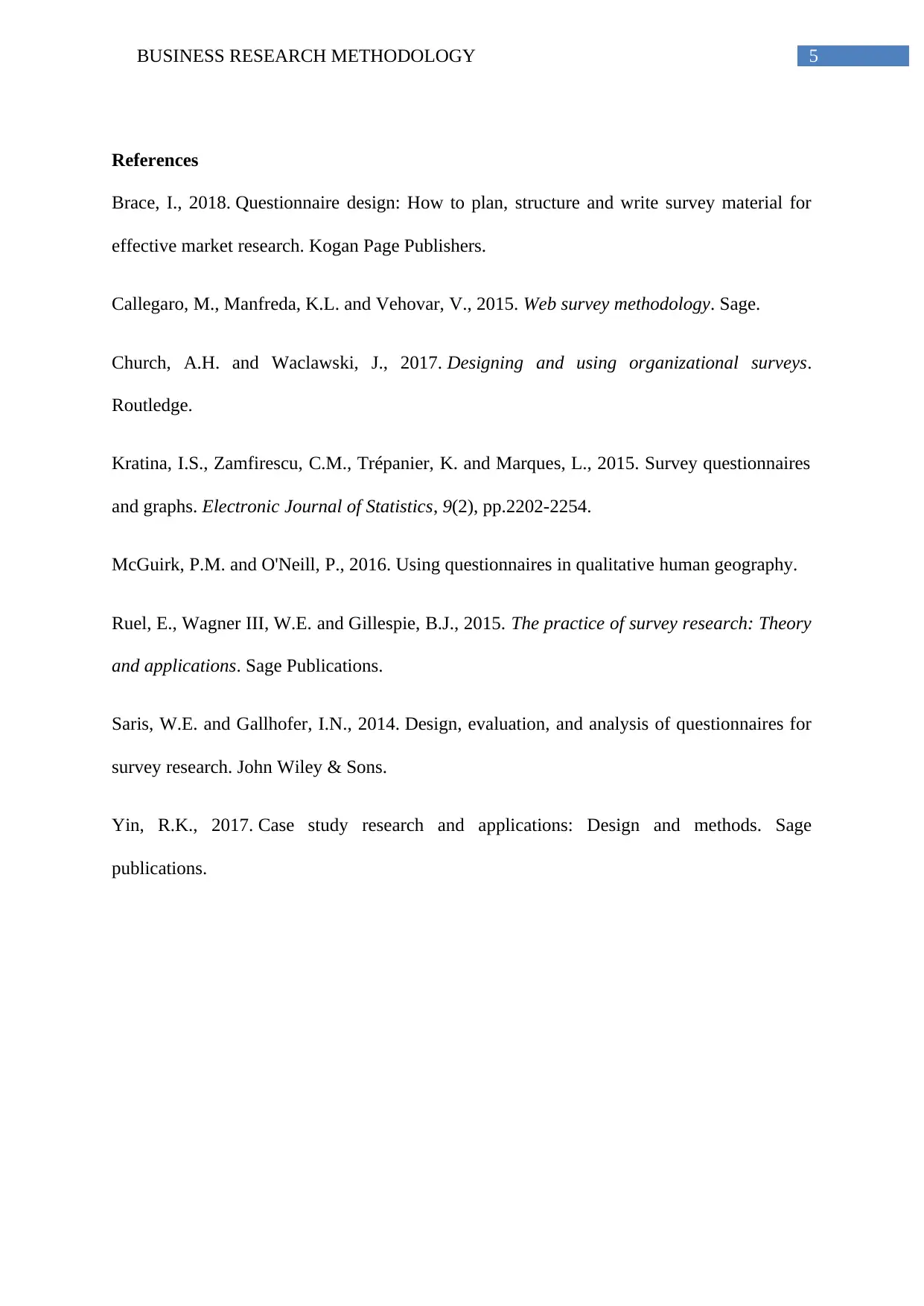
5BUSINESS RESEARCH METHODOLOGY
References
Brace, I., 2018. Questionnaire design: How to plan, structure and write survey material for
effective market research. Kogan Page Publishers.
Callegaro, M., Manfreda, K.L. and Vehovar, V., 2015. Web survey methodology. Sage.
Church, A.H. and Waclawski, J., 2017. Designing and using organizational surveys.
Routledge.
Kratina, I.S., Zamfirescu, C.M., Trépanier, K. and Marques, L., 2015. Survey questionnaires
and graphs. Electronic Journal of Statistics, 9(2), pp.2202-2254.
McGuirk, P.M. and O'Neill, P., 2016. Using questionnaires in qualitative human geography.
Ruel, E., Wagner III, W.E. and Gillespie, B.J., 2015. The practice of survey research: Theory
and applications. Sage Publications.
Saris, W.E. and Gallhofer, I.N., 2014. Design, evaluation, and analysis of questionnaires for
survey research. John Wiley & Sons.
Yin, R.K., 2017. Case study research and applications: Design and methods. Sage
publications.
References
Brace, I., 2018. Questionnaire design: How to plan, structure and write survey material for
effective market research. Kogan Page Publishers.
Callegaro, M., Manfreda, K.L. and Vehovar, V., 2015. Web survey methodology. Sage.
Church, A.H. and Waclawski, J., 2017. Designing and using organizational surveys.
Routledge.
Kratina, I.S., Zamfirescu, C.M., Trépanier, K. and Marques, L., 2015. Survey questionnaires
and graphs. Electronic Journal of Statistics, 9(2), pp.2202-2254.
McGuirk, P.M. and O'Neill, P., 2016. Using questionnaires in qualitative human geography.
Ruel, E., Wagner III, W.E. and Gillespie, B.J., 2015. The practice of survey research: Theory
and applications. Sage Publications.
Saris, W.E. and Gallhofer, I.N., 2014. Design, evaluation, and analysis of questionnaires for
survey research. John Wiley & Sons.
Yin, R.K., 2017. Case study research and applications: Design and methods. Sage
publications.
⊘ This is a preview!⊘
Do you want full access?
Subscribe today to unlock all pages.

Trusted by 1+ million students worldwide
1 out of 6
Related Documents
Your All-in-One AI-Powered Toolkit for Academic Success.
+13062052269
info@desklib.com
Available 24*7 on WhatsApp / Email
![[object Object]](/_next/static/media/star-bottom.7253800d.svg)
Unlock your academic potential
Copyright © 2020–2025 A2Z Services. All Rights Reserved. Developed and managed by ZUCOL.



